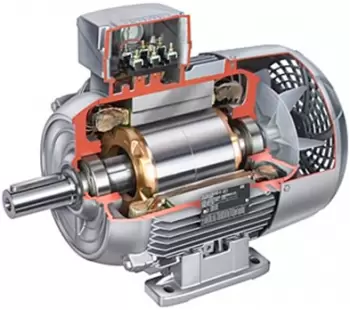
Synchronous motor is a type of alternating current motor. The speed of rotation (synchronism speed) is constant and is synchronized with the frequency of the electrical voltage to which it is connected and the number of pairs of poles of the motor.
These are typically three-phase motors, but small-power synchronous motors are often powered by the common single-phase voltage available in homes. Synchronous motor is also called vector motor or Rowan motor.
Like all electric motors, the purpose of the synchronous motor is to transform electrical energy into mechanical energy.
The same electrical machine that works as a synchronous motor can also be used as an electrical generator, and in this case it is called an alternator. Most of the electric generators are in fact of this type.
Synchronous motors are so named because the speed of the stator and rotor are the same.
Synchronous motors are used in large machines that have a variable load and require constant rotor speed.
What is a synchronous motor?
The synchronous motor is made up of the rotor and the stator.
The rotor is the rotating part integral with the shaft in which there are several magnetic poles of alternating polarity created by permanent magnets or electromagnets. The electromagnets are powered by direct current (called excitation current).
In the stator in the power circuit windings are present. The pole pieces of the stator create a rotating magnetic field. The magnetic field of the stator drives the pole pieces of the rotor.
The mathematical expression that relates the speed of the machine with the mentioned parameters is:
![]()
where:
-
f: frequency of the electrical network to which the machine is connected (Hz)
-
P: Number of pairs of poles that the machine has
-
p: Number of revolutions per minute of the shaft.
-
n: machine synchronization speed (revolutions per minute)
For example, if you have a four pole machine (2 pole pairs) connected to a 50 Hz electrical current, the rotor rotates at 1,500 rpm.
How do you start a synchronous motor?
Starting this type of motor is relatively complex because it has an impulse torque curve centered on the frequency of the stator supply current. This means that the rotor has a drag torque only and exclusively if it rotates at the same frequency as the alternating current of the stator.
Therefore, when the motor stops, the application of the alternating voltage cannot make the motor start because the rotor has zero torque. To do this, the motor is initially brought to final rotational speed by an asynchronous motor. Then, after having disconnected the latter, the supply voltage is connected at the same frequency of rotation reached and, subsequently, the mechanical load of the user is inserted.
In addition to physically having 2 motors in parallel, this can also be achieved with synchronous motors made expressly for this purpose and then switching to synchronous mode.
In recent years, the use of power electronics has dramatically simplified commissioning.
Thus, starting from the zero frequency and making it grow very gradually, a torque is continuously activated that is capable of accelerating the motor from standstill.
What is the difference between synchronous motor and asynchronous motor?
Compared with an asynchronous motor (or induction motor), the synchronous motor is not capable of adapting to significant variations in resistance torque.
In fact, if once at full speed the rotation is braked or accelerated beyond a certain limit, a series of oscillations are triggered, causing the motor to lock up and can cause strong overcurrents that can damage the motor. In addition, overcurrent protection must be provided.
How to brake a three-phase synchronous motor?
As a general rule, the desired speed of this type of motor is carried out by means of a rheostat.
The synchronous motor when it reaches the critical torque will stop, this is not the most orthodox way to do it. Critical torque is reached when the load assigned to the motor exceeds the motor torque.
However, the best way to do it is to vary the load until the current absorbed from the network is as low as possible, then we disconnect the motor. Another way to do it, and more commonly, is to regulate the rheostat, so we vary the intensity and we can disconnect the motor without any risk.